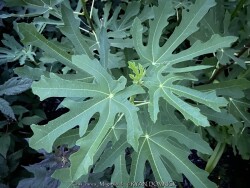
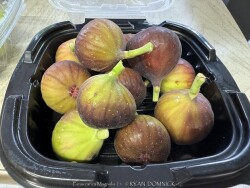
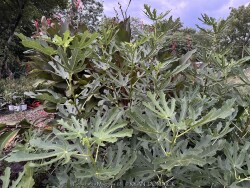
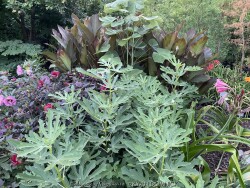
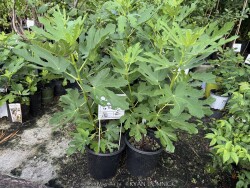
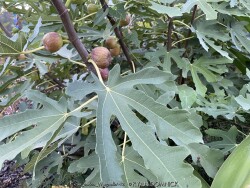

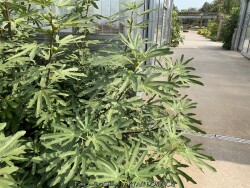
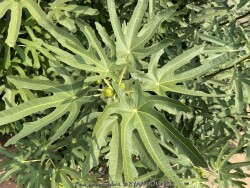
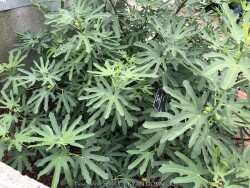
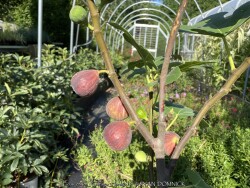
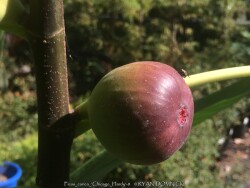
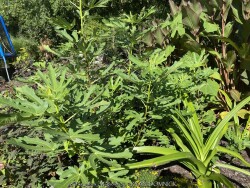
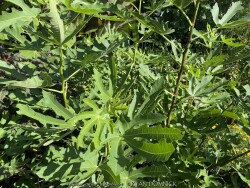
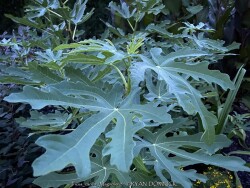
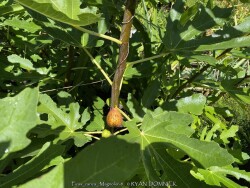

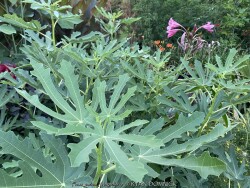
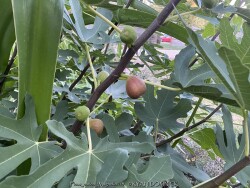

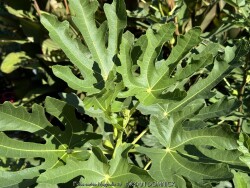
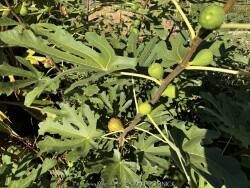
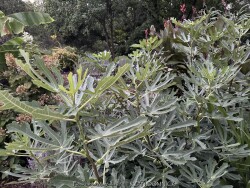
Plant Min Zone: 5b
Plant Max Zone: 11b
Sunlight: Full Sun, Part Sun
Water / Rainfall: Low, Average, High
Soil Quality: Average, Rich
Bloom Season: Insignificant
Flower Color: Insignificant
Berry / Fruit Color: Brown-Beige
Spring Foliage Color: Green
Summer Foliage Color: Green
Fall Foliage Color: Green
Evergreen Foliage: No
Winter Interest: No
Scented Flowers: Yes
Drought Tolerance: Medium
Wet-Feet Tolerance: Low
Humidity Tolerance: High
Wind Tolerance: Medium
Poor Soil Tolerance: Clay Soils
Height: 3' - 5'
Width: 3' - 5'
Growth Rate: Medium, Fast
Service Life: Medium: 3-5 years
Maintenance Need: Low
Spreading Potential: Low
Yearly Trimming Tips: Shrub Normally Winter-kills so trim to 3-6" off Ground in Winter or Early Spring: Blooms on New Wood.
Plant Grouping Size: Specimen Planting of 1-3
Best Side of House: South Exposure, West Exposure
Extreme Planting Locations: Resistant to Rabbits
Ornamental Features: Multiple Seasons of Interest, Easy to Eat Edibles, Large Tropical Foliage / Flowers, Exceptional / Colorful Foliage
Special Landscape Uses: None
Possible Pest Problems: None
Plant Limitations: May get Occasional Winter-kill, Needs Thick Winter Mulch, Late to Emerge or Leaf Out in Spring
Shippable in 2026: YES
The common fig (Ficus carica) is native to an area extending from Asiatic Turkey to northern India. In Kansas, plant in a protected area near the house on south or west side but will survive in other locations in full hot sun. As an edible, ornamental plant, figs are an attractive bush-like plant with sandpapery green sometimes deeply lobed leaves. There is a slight and pleasant aroma when brushing against the foliage. Fruits are dark purple to maroon. Figs love full hot sun and are very drought tolerant but will produce more fruit if watered during the summer. Expect fig tree to die to the ground each year and start growing in May a bit later than other plants. Regrowth is rapid and established figs will have dozens of 5-6' water sprouts loaded with a few hundred fruits by September. You will always get a late summer/fall crop because fruit can come from new wood. If growing as a potted patio plant, grow in full sun with plenty of water during the summer. Then in late fall before temperatures get below 20 degrees F, move into a cold garage or basement over the winter with minimal watering. Do not allow the pot with rootball to freeze solid or go below 15 degrees for more than a few hours. By March or April, the fig will be trying to grow and you may put back outside (protect from late frosts) and you will also have a spring fruit crop. Eat fresh, freeze for fruit smoothies, or dry in sun or food dehydrator. In our trial gardens in Lawrence, KS (zone 6a), three specimens planted in 2020 and mulched 1-3" with wood mulch. Surprisingly, they survived -17 degrees F. During that arctic blast of February, 2021, lows down to -17 degrees F on Feb 16th, 2021 were recorded. The longevity of this cold blast was also impressive: 10 days on a row with highs of 10-15 degrees F or lower, 8 nights of lows in the single digits and negatives, and 36 straight hours of 0 degrees F and mostly lower. Magnolia Large Fruiting Fig (Ficus carica 'Magnolia') has slightly larger more deeply lobed foliage that is more ornamental. The fruit is large with brown skin and amber pulp. Pick the fruit just before maturity for a perfect flavor and to avoid souring and splitting. Sometimes if prolonged September cold-fronts occur and temperatures are too low at night, green fruits will disappointingly stop ripening. Look for a hot planting location microclimate such as a West or South wall to encourage fruit to ripen. Ripening does not continue to progress if harvested early (when fruit has any green coloring present).